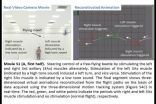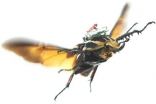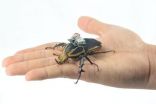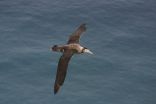(Press-News.org) Berkeley -- Hard-wiring beetles for radio-controlled flight turns out to be a fitting way to learn more about their biology. Cyborg insect research led by engineers at the University of California, Berkeley, and Singapore's Nanyang Technological University (NTU) is enabling new revelations about a muscle used by beetles for finely graded turns.
By strapping tiny computers and wireless radios onto the backs of giant flower beetles and recording neuromuscular data as the bugs flew untethered, scientists determined that a muscle known for controlling the folding of wings was also critical to steering. The researchers then used that information to improve the precision of the beetles' remote-controlled turns.
This study, to be published Monday, March 16, in the journal Current Biology, showcases the potential of wireless sensors in biological research. Research in this field could also lead to applications such as tools to aid search-and-rescue operations in areas too dangerous for humans.
"This is a demonstration of how tiny electronics can answer interesting, fundamental questions for the larger scientific community," said Michel Maharbiz, an associate professor in UC Berkeley's Department of Electrical Engineering and Computer Sciences and the study's principal investigator. "Biologists trying to record and study flying insects typically had to do so with the subject tethered. It had been unclear if tethering interfered with the insect's natural flight motions."
In particular, the researchers said, it had been difficult to elucidate the role that smaller muscles play in fine steering. What the new study found was that the coleopteran third axillary sclerite (3Ax) muscle, found in the articulation of insect wings, plays a key function in the beetle's ability to steer left or right.
"Since the 1800s, this coleopteran muscle was thought to function solely in wing folding," said study lead author Hirotaka Sato, an assistant professor at NTU's School of Mechanical and Aerospace Engineering. "Our wireless system allows us to record neuromuscular movements in natural, free flight, so we see now that this muscle is also used for turning."
Steering muscle put to the test
The researchers tested the function of this muscle by stimulating it during flight for graded turns that were more controlled than previous versions of the cyborg beetle.
Experiments were done with Mecynorrhina torquata, or giant flower beetles. They averaged 6 centimeters in length and 8 grams in weight, about as heavy as a $1 coin.
The beetle backpack is made up of a tiny, off-the-shelf microcontroller and a built-in wireless receiver and transmitter. Six electrodes are connected to the beetle's optic lobes and flight muscles. The entire device is powered by a 3.9-volt micro lithium battery and weighs 1 to 1.5 grams.
"Beetles are ideal study subjects because they can carry relatively heavy payloads," said Sato, who began the work while he was a postdoctoral researcher at UC Berkeley and has continued the project at NTU. "We could easily add a small microphone and thermal sensors for applications in search-and-rescue missions. With this technology, we could safely explore areas not accessible before, such as the small nooks and crevices in a collapsed building."
During test flights, signals were transmitted to the beetle backpack every millisecond, directing the beetles to take off, turn left or right, or even hover in mid-flight. The beetles were untethered but in a closed room equipped with eight 3-D motion-capture cameras.
"In our earlier work using beetles in remote-controlled flight, we showed excellent control of flight initiation and cessation, but relatively crude control of steering during free flight," said Maharbiz. "Our findings about the flight muscle allowed us to demonstrate for the first time a higher level of control of free-flying beetles. It's a great partnership between engineering and science."
INFORMATION:
This work was supported by the Nanyang Assistant Professorship and the Agency for Science, Technology and Research in Singapore, and the National Science Foundation in the United States.
In the face of global climate change, increasing the use of renewable energy resources is one of the most urgent challenges facing the world. Further development of one resource, solar energy, is complicated by the need to find space for solar power-generating equipment without significantly altering the surrounding environment.
New work from Carnegie's Rebecca R. Hernandez (now at University of California Berkley), Madison K. Hoffacker, and Chris Field found that the amount of energy that could be generated from solar equipment constructed on and around existing infrastructure ...
Northwestern University scientists have developed a robust new material, inspired by biological catalysts, that is extraordinarily effective at destroying toxic nerve agents that are a threat around the globe. First used 100 years ago during World War I, deadly chemical weapons continue to be a challenge to combat.
The material, a zirconium-based metal-organic framework (MOF), degrades in minutes one of the most toxic chemical agents known to mankind: Soman (GD), a more toxic relative of sarin. Computer simulations show the MOF should be effective against other easy-to-make ...
"Warmer air transports more moisture and hence produces more precipitation - in cold Antarctica this takes the form of snowfall," lead author Katja Frieler from the Potsdam Institute for Climate Impact Research (PIK) explains. "We have now pulled a number of various lines of evidence together and find a very consistent result: Temperature increase means more snowfall on Antarctica," says Frieler. "For every degree of regional warming, snowfall increases by about 5 percent." Published in the journal Nature Climate Change, the scientists' work builds on high-quality ice-core ...
Researchers have discovered a valley underneath East Antarctica's most rapidly-changing glacier that delivers warm water to the base of the ice, causing significant melting.
The intrusion of warm ocean water is accelerating melting and thinning of Totten Glacier, which at 65 kilometres long and 30 kilometres wide contains enough ice to raise global sea levels by 3.5 metres. The glacier is one of the major outlets for the East Antarctic Ice Sheet, which is the largest mass of ice on Earth and covers 98 percent of the continent.
Climate change is raising the temperature ...
CORVALLIS, Ore. - A new study confirms that snowfall in Antarctica will increase significantly as the planet warms, offsetting future sea level rise from other sources - but the effect will not be nearly as strong as many scientists previously anticipated because of other, physical processes.
That means that many computer models may be underestimating the amount and rate of sea level rise if they had projected more significant impact from Antarctic snow.
Results of the study, which was funded by the National Science Foundation, were reported this week in the journal ...
About one quarter of the global seafloor is extremely nutrient poor. Contrary to previous assumptions, it contains oxygen not just in the thin surface layer, but also throughout its entire thickness. The underlying basement rocks contain oxygen as well. An international research team made these new discoveries through analysis of drill cores from the South Pacific Gyre.
In the latest issue of Nature Geoscience the scientists also point out the potential effects on the composition of Earth's interior because oxygen-containing deep-sea sediment has a different mineral composition ...
The underlying mechanism behind an enigmatic process called "singlet exciton fission", which could enable the development of significantly more powerful solar cells, has been identified by scientists in a new study.
The process is only known to happen in certain materials, and occurs when they absorb light. As the light particles come into contact with electrons within the material, the electrons are excited by the light, and the resulting "excited state" splits into two.
If singlet exciton fission can be controlled and incorporated into solar cells, it has the potential ...
Climbing rats, seabirds and tropical gophers are among the 15 animal species that are at the absolute greatest risk of becoming extinct very soon. Expertise and money is needed to save them and other highly threatened species.
A new study shows that a subset of highly threatened species - in this case 841 - can be saved from extinction for about $1.3 billion a year. However, for 15 of them the chances of conservation success are really low.
The study published in Current Biology concludes that a subset of 841 endangered animal species can be saved, but only if conservation ...
New heart imaging technology to diagnose coronary heart disease and other heart disorders is significantly more accurate, less expensive and safer than traditional methods, according to a new study by researchers from the Intermountain Medical Center Heart Institute in Salt Lake City.
Researchers at the Intermountain Medical Center Heart Institute compared Single Photon Emission Computed Tomography (SPECT), currently the most commonly used imaging diagnostic tool, with a new imaging technology -- coronary-specific Positron Emission Tomography (cardiac PET/CT).
They ...
Montreal, March 16, 2015 -- Does a predilection for porn mean bad news in bed? That's the conclusion of many clinicians and the upshot of anecdotal reports claiming a man's habit of viewing sex films can lead to problems getting or sustaining an erection.
But a new study from UCLA and Concordia University -- the first to actually test the relationship between how much erotica men are watching and erectile function -- shows that viewing sexual films is unlikely to cause erectile problems and may even help sexual arousal.
The study, published in the online journal Sexual ...




